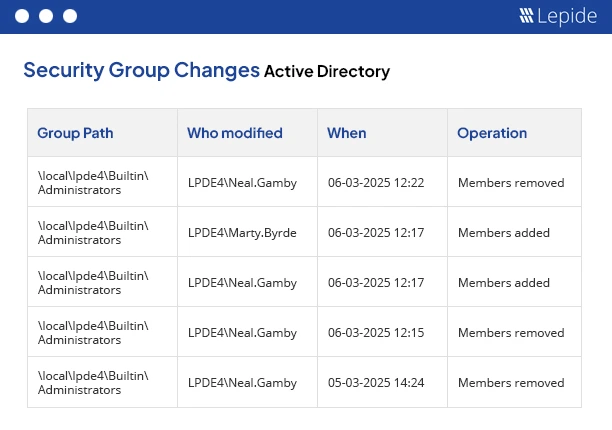
Active Directory is the backbone of access control for the majority of organizations. Resource authorization and user authentication are two of its major aspects . But as teams grow and roles change, permissions accumulate silently.
This results in permission sprawl, and if left unchecked, can open the door to privilege abuse, ransomware and failed audits.
What is Permission Sprawl?
Permission sprawl is the gradual buildup of excessive access rights across users and groups – far beyond what’s needed for their roles.
Due to ad hoc requests, brief initiatives, or position changes, users gradually accumulate varying degrees of access across numerous systems and resources.
When these rights are no longer required, they should be revoked – but they rarely are. Because of this, users are given significantly more access than is necessary for too long, which makes the environment challenging to control and secure.
How Permission Sprawl Happens in Active Directory
Active Directory permissions are often susceptible to permission sprawl because of how they are structured and used. Here’s how it typically happens:
- Group Nesting Complexity: AD allows groups to reside inside of one other, which can result in permission systems with several layers. Heavily nested group structures are the most common ones that hide inherited rights.
Without careful administration, this could lead to nested permission layers that are exceedingly challenging to manually keep an eye on. The risk of unauthorised access might be increased by such complexity, which can make it unclear who has access to what resources. - Role Changes and Lack of De-Provisioning: Employees who move between departments or roles frequently get new permissions that are suitable for their new duties.
When they move departments or take on new responsibilities, administrators often give them new permissions without taking away their old ones. However, their prior permissions stay in effect if they are not properly deprovisioned, which results in an accumulation of access privileges that are more than necessary.Without timely action, this permission creep can present serious security threats. - Temporary Access becomes Permanent: For emergencies or initiatives, temporary licenses are commonly issued. After their intended use, these rights are regrettably frequently not revoked. This leads to extended access that, if ignored, can be abused.
- Lack of Regular Auditing and Monitoring: It is challenging to find and fix excessive or out-of-date permissions without regular audits. To guarantee that access rights correspond with current roles and responsibilities, regular reviews are necessary.
Unauthorised access and possible security problems could be avoided with the support of routine monitoring and auditing. - Overuse of Privileged Accounts: For administrative convenience, organisations occasionally set up several privileged accounts. As a result, the attack surface for possible breaches may grow due to an excess of high-level access accounts.
In the absence of frequent audits and stringent safeguards, these accounts may be abused or turn into easy targets for hackers. - Improper Lifecycle Management: Timely provisioning, frequent reviews, and rapid de-provisioning of access rights are all essential components of a strong lifecycle strategy that is necessary for effective permission management.
It is vital to understand that if any aspect of this life cycle is overlooked, permission sprawl may result, allowing users to keep access they no longer require. - Improper Knowledge of Permission Inheritance: Insufficient knowledge may prevent administrators from fully understanding how permissions are transmitted down through nested groups and result in unauthorized access rights.This lack of knowledge could result in the issuance of permissions that are far too general, which could be hazardous for security.The business can maintain a secure and manageable Active Directory environment by understanding permission inheritance.
Why Permission Sprawl is a Security Risk
Here are the key points explaining why permission sprawl is a serious security risks:
- Increased Attack Surface: The potential harm from compromised accounts is increased by having too many permissions. By taking advantage of accounts with excessive permissions, attackers can access sensitive information, move laterally within networks, and escalate privileges.In development settings, for example, if a developer’s credentials are hacked, the default admin access to repositories can let attackers take over the entire system.
- Undermines PoLP: Giving users more permissions than they require goes against the security best practice. To lessen the possible impact of compromised accounts, make sure users only have the access required for their responsibilities.To find and remove unused permissions, do audits on a regular basis.
- Operational Inefficiencies: Environments with excessive permissions make security management more difficult. Administrators may find it difficult to determine who has access to what, which could cause audits and investigations to lag.This ambiguity can make it more difficult to respond quickly to security issues and raise the possibility of privilege abuse.
- Compliance Violations: To safeguard sensitive data, laws like GDPR, HIPAA, PCI DSS, and SOX require stringent access restrictions. Unauthorised access to data can come from permission sprawl, which can cause non-compliance and possible fines.Role-based access control (RBAC) helps enforce these rules by keeping audit trails and restricting access according to job duties.
- Financial Implications: Financial repercussions may result from permission sprawl in addition to security and compliance issues. Resource consumption and the potential need for extra security solutions result from managing too many permissions, which raises operating expenses.Furthermore, the costs of cleanup and reputational harm might result in large financial losses for a breach brought on by authorisation sprawl.
Signs Your AD is Affected by Permission Sprawl
Here are the key signs that your Active Directory is suffering from permission sprawl:
- Unmanaged Growth of Privileged Accounts: It greatly expands your attack surface when too many users are given privileged or administrative access, such Domain Admin or local admin rights.An increase in these accounts, frequently brought on by unclear inheritance laws or nested group complexity, has resulted in expensive events like ransomware breaches.
- Dormant accounts have permissions: With active permissions, inactive accounts such as those of guests, unused service accounts, or retired employees can stay enabled.If these orphaned credentials are not quickly deprovisioned, they frequently persist following organizational changes and make tempting targets for attackers.
- Inadequate Procedures for Auditing and Logging: Unintentional or unauthorised permission modifications may go undetected in the absence of thorough event logs and routine auditing.The best practices place a high emphasis on Active Directory event log monitoring, which includes keeping track of group adjustments, policy changes, and account management.
- Outdated Configurations: Due to out-of-date default permissions or faulty inheritance rules, access control lists (ACLs) may eventually become misconfigured.Until proactive methods are used for identification, these problems frequently remain unfixed, resulting in exploitable permission gaps.
- SSO/OAuth Tokens Grant Access: In order to move covertly between systems, attackers are increasingly taking advantage of sprawl using methods like stolen SSO or OAuth tokens, which allow them to use genuine access rights.Significant hacks such as those at Marks & Spencer serve as examples of how token sprawl and centralised identification can be used as weapons.
How to Prevent Permission Sprawl
The preventative measures to prevent permission sprawl is as follow:
- Review Permissions Regularly: Employing automated tools to streamline reviews and preserve thorough audit trails, conduct scheduled access reviews for sensitive accounts at least once every three months to identify who has what access, flag unused privileges, and eliminate superfluous ones.
- Implementation of Least Privilege Principle: The Least Privilege Principle’s implementation includes requiring multi-factor authentication for admin operations, enforcing just-in-time privilege elevation, and implementing role-based or attribute-based access control to ensure users have just the rights necessary for their tasks.
- Awareness of Permission Management: To create a culture that is security-conscious, the teams should receive training on access hygiene, which includes least privilege ideas, the dangers of orphaned accounts, just-in-time access processes, and the significance of reporting shadow IT.
- Automate Lifecycle Management: The last step is to automate lifecycle management by linking HR systems with your IAM/PAM products. This will guarantee that roles, onboarding, transfers, and terminations initiate workflows for automatic provisioning and deprovisioning, privilege recertifications, and alerts regarding stale entitlements.
By combining these strategies, access privileges may be proactively and scalablely controlled, lowering risk and increasing compliance.
How Lepide Helps
Lepide Auditor for Active Directory gives you full visibility into permissions and group memberships, helping you detect excessive access and fix it fast.
Key benefits:
- See who has access to what – instantly.
- Spot dormant or high-risk accounts.
- Get real-time alerts on permission changes.
- Automate access reviews and streamline compliance reporting.
Whether you’re dealing with nested groups, legacy permissions, or inactive accounts, Lepide gives you the tools to reduce risk and take back control of AD access.
Want to uncover over‑privileged users in your AD environment? Schedule a demo with one of our engineers or download a Free Trial.


